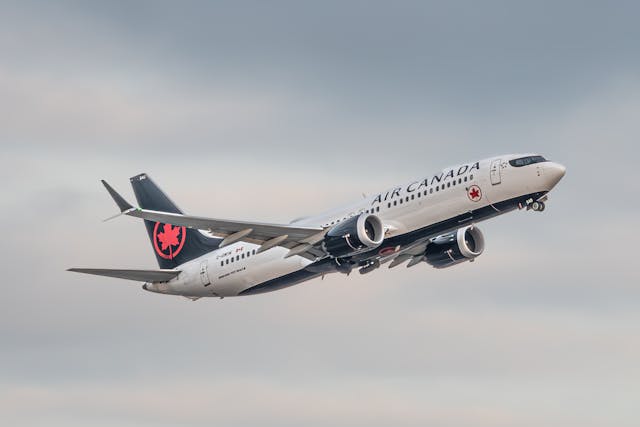
Why do planes use halon fire extinguishers? Halon fire extinguishers are used on planes because they don’t conduct electricity, they don’t leave a residue, they put out the fire effectively, and they are not very toxic to people.
There are many different types of fire extinguisher, but they all work on generally the same principle. A fire needs three things to burn: fuel, heat, and oxygen. This is called the fire triangle. The job of a fire extinguisher is to remove one of these three things and break the fire triangle. Simple extinguishers that contain water cool down the fire, removing the heat, and smothering the fuel so that it cannot get oxygen. Dry powder extinguishers spray out a powder that melts, removing the heat, and blocks the oxygen. Foam extinguishers cover the fuel and block out the oxygen. Carbon dioxide fire extinguishers removes the oxygen and takes heat out of the fire when it turns into a liquid. Different substances require different types of extinguisher. For example, you cannot use a water extinguisher on an oil fire because the water will boil and explode, pushing the burning oil out with it, making the fire worse.
A fire on a plane is one of the worst emergencies there can be. Unless the fire can be put out in the air, the plane needs to be put on the ground and the passengers evacuated as quickly as possible. Depending on the fire, often there are only a few minutes to do this. If the plane is over land, great, but if it is out at sea, this can be problematic. Plane fires and plane crashes in general are far more survivable now than they used to be and far more survivable than the media would lead us to believe. One of the reasons for this is because of improvements to the planes. After a series of accidents caused by fires on planes, there were a large number of changes. The number of flammable components to the plane have been drastically reduced. The seats are made of flame retardant foam and coverings. They are tested with blowtorches to see how long before they ignite, and this change alone gives passengers an extra few minutes to get off the plane. There are multiple redundant systems so that the plane can still fly if something does burn. The fire detection systems are very advanced and the plane has a fire suppression system. And this is what I want to look at today.
Halon is an excellent fire suppression system because it is a heavy gas, five times denser than air, which means it falls and smothers the fire. It removes the oxygen from the fire triangle and can remove heat from the fire as well in a chemical reaction.
The aircraft fire suppression system and the fire extinguishers dotted around the plane all contain halon. Why is this? The first reason is that it is a very light gas and halon extinguishers weigh less than other types of system. This is very important on a plane where every kg counts.
The second reason is that halon extinguishers don’t conduct electricity. Water fire extinguishers and some foam extinguishers conduct electricity. On a plane, often the cause of the fire is an electrical short, and if you use a medium that conducts electricity to extinguish the fire, it might cause shorts in other places. Halon does not conduct electricity.
The third reason is that they work on all types of fire. A fire on a plane could be electrical, it could be burning oil, it could be something a customer has brought on the plane. There is no way of knowing and you can’t have multiple systems. Halon works on all of them.
The fourth reason is that the halon disappears once it has been used and after it puts out a fire there is no residue. Water, carbon dioxide, and foam extinguishers all leave a residue, which can cause even more damage.
The fifth reason is that halon is not very toxic. That is to say that halon is toxic, but you would have to inhale a considerable amount of it for there to be any damage. Breathing in the small amount you would get if a halon extinguisher was used on a plane would not have any effect. In fact, the real danger and the real toxicity would come from the burning materials on the plane. Plastics and many other materials give off very toxic fumes when they burn. Halon puts out a fire faster than almost any other fire extinguisher, so its low toxicity is an acceptable risk.
Halon is amazingly useful on a plane and is the best available fire suppressant, but it is a hydrocarbon, and thus technically banned because of the damage it does to the ozone layer. All hydrocarbons were banned in 1994 through an international treaty, and it is no longer possible to manufacture halon. Airlines have been given a moratorium because it is the best available material, but supplies are running out. There is a lot of research into what material to use to replace them when they can no longer use halon extinguishers. The goal is to phase halon out by 2025. And this is what I learned today.
Sources
https://skybrary.aero/articles/halon-fire-extinguishers
https://www.protectionrt.com/halon-toxicity
https://www.explainthatstuff.com/fireextinguisher.html
https://www.h3raviation.com/pages/faq
Photo by Airborne YVR: https://www.pexels.com/photo/passenger-airplane-rising-up-19882330/

Pingback: #157 When did we start using fire extinguishers?
Pingback: #1117 Why are many mushrooms dangerous?
Pingback: #910 What is a metal?
Pingback: #509 Why do dry rooms have more static?